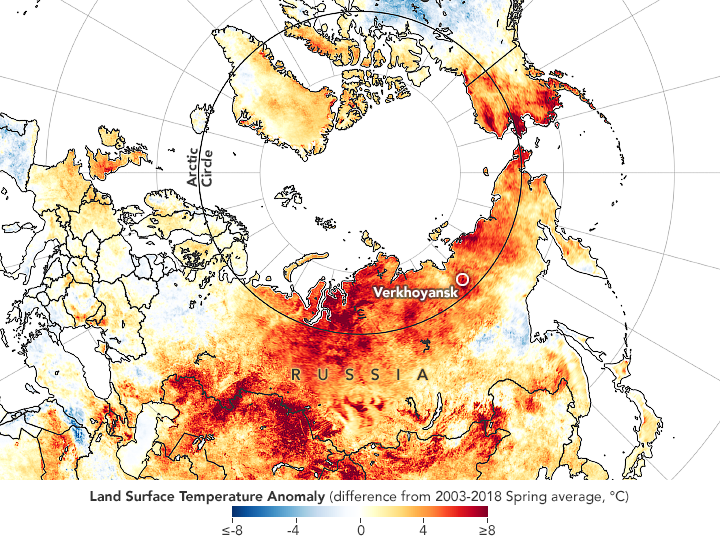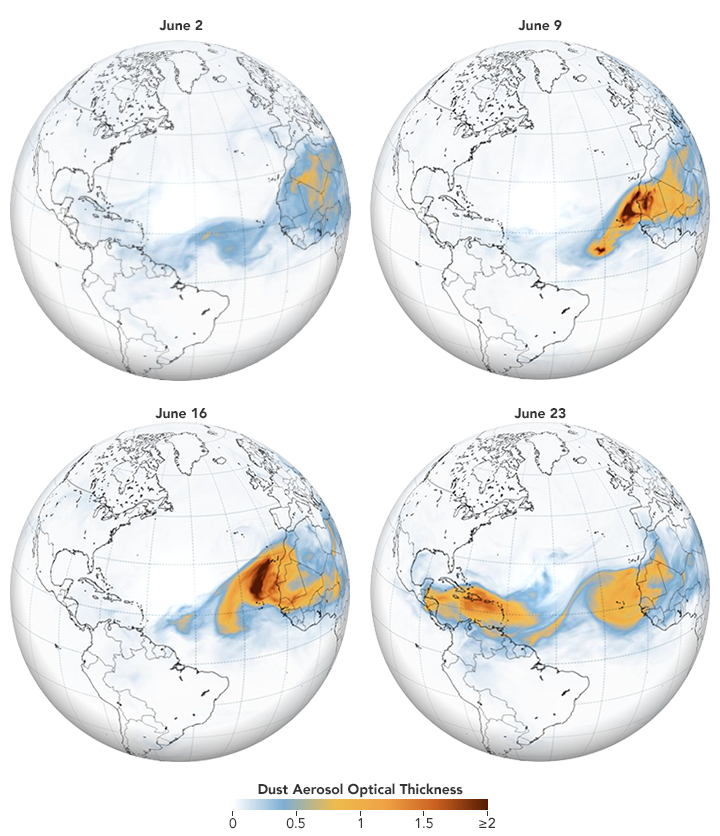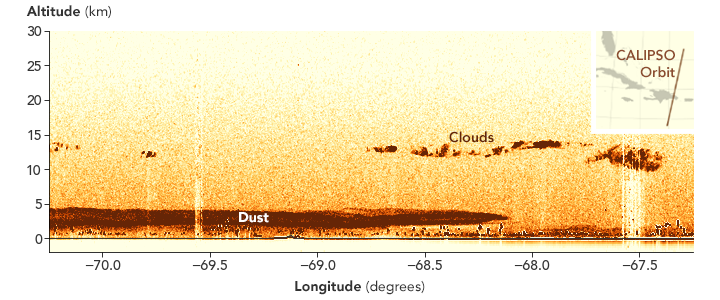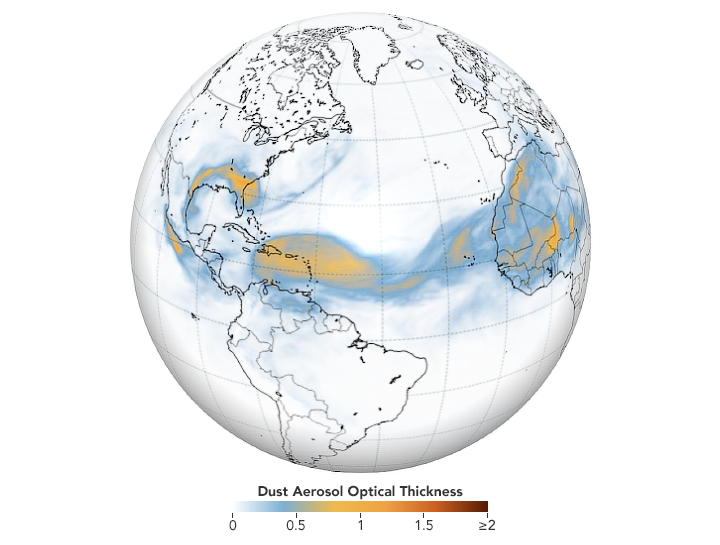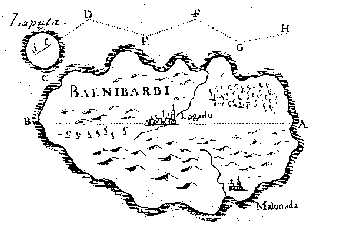https://earthobservatory.nasa.gov/images/146879/heat-and-fire-scorches-siberia wrote:
Heat and Fire Scorches Siberia
<<Eastern Siberia is famous for some of the coldest wintertime temperatures in the Northern Hemisphere. But in 2020, it has been the region’s wildly high temperatures and wildfires that have wowed meteorologists.
After several months of warm weather, the Russian town of Verkhoyansk reported a daytime temperature of 38°C (100.4°F) on June 20—likely a record high for the town. (The previous high was 37.3°C, recorded on July 25, 1988.) If verified, this will be the northernmost temperature reading above 100°F ever observed and the highest temperature on record in the Arctic, according to the Capital Weather Gang.
“This event seems very anomalous in the last hundred years or so,” said NASA Goddard Institute for Space Studies Director Gavin Schmidt. “The background trends in temperature in this region are about 3 degrees Celsius since the 19th century, so the probabilities of breaking records there are increasing fast.”
The map at the top of the page shows land surface temperature anomalies from March 19 to June 20, 2020. Red colors depict areas that were hotter than average for the same period from 2003-2018; blues were colder than average. The map is based on data from the Moderate Resolution Imaging Spectroradiometer (MODIS) on NASA’s Aqua satellite.
Note that the map depicts land surface temperatures (LSTs), not air temperatures. LSTs reflect how hot the surface of the Earth would feel to the touch and can sometimes be significantly hotter or cooler than air temperatures. (To learn more about land surface temperatures and air temperatures, read: Where is the Hottest Place on Earth?)
In a report about the remarkably warm temperatures in Siberia, European scientists examined historical temperature data in their global ERA5 reanalysis, finding that temperatures have been unusually warm in the region since January 2020. Since the ERA5 data begins in 1979, the European team also looked to GISTEMP, a NASA temperature record with data through 1880. They could not find any other examples in either dataset of such an intense heat wave in this part of Siberia persisting for such an extended period.
The persistent high-pressure atmospheric pattern that brought the extreme heat has exacerbated wildfires, prompting dozens to burn in the region’s forest and shrub ecosystems. Some of those ecosystems grow on top of carbon-rich layers of peat and permafrost. The natural-color image below shows smoke streaming from several active wildfires in Russia's Sakha region.
“Most of Earth’s terrestrial carbon is stored in the upper latitudes of the northern hemisphere,” explained Amber Soja, a NASA and National Institute of Aerospace associate research fellow who has conducted field research in the region. Soja noted that many forests in the region are dominated by a coniferous tree—Dahurian larch—that drops its needles each winter. “But because the winters are so cold, there are few decomposers around to break the needles down. Over time, you end up with lots of buried fuel that has built up over millennia, which stores massive quantities of carbon in peat and soils.”
Intense heat waves can thaw the permafrost layer and make long-frozen deposits susceptible to fires, which move carbon from the ground to the atmosphere and contribute to global concentrations of greenhouse gases. “In this part of Siberia, the signs of climate change are already here. It’s not some distant future. It’s now,” she said. “The heat and fires this year are just adding more evidence to the climate change signal that we have seen in these forests for years.”
Though it is still early in the fire season, satellite observations of active fires by NASA and NOAA’s MODIS and VIIRS sensors show the number of fire detections to be among the highest observed in any year since 2003. “Over the Russian Far East, there has been about the same amount of fire as last year, another very active year,” said NASA and Columbia University scientist Robert Field. “Both 2020 and 2019 were about twice the 2003–2020 average, and about half as much as 2011, the most active year.”>>
Weather!
- neufer
- Vacationer at Tralfamadore
- Posts: 18805
- Joined: Mon Jan 21, 2008 1:57 pm
- Location: Alexandria, Virginia
Re: Weather!
Art Neuendorffer
-
BDanielMayfield
- Don't bring me down
- Posts: 2524
- Joined: Thu Aug 02, 2012 11:24 am
- AKA: Bruce
- Location: East Idaho
Re: Weather!
Wow. Heat is scorching Alaska too. And all this extra Arctic heat is happening during a spring in which there was a reduction of man made CO2 release due to global covid-19 slowdowns that I'm guessing where far larger than the protocols were even calling for. This is evidence to me that Earth has already been pushed far beyond a global warming tipping point.neufer wrote: ↑Thu Jun 25, 2020 2:10 amhttps://earthobservatory.nasa.gov/images/146879/heat-and-fire-scorches-siberia wrote:
Heat and Fire Scorches Siberia
<<Eastern Siberia is famous for some of the coldest wintertime temperatures in the Northern Hemisphere. But in 2020, it has been the region’s wildly high temperatures and wildfires that have wowed meteorologists.
After several months of warm weather, the Russian town of Verkhoyansk reported a daytime temperature of 38°C (100.4°F) on June 20—likely a record high for the town. (The previous high was 37.3°C, recorded on July 25, 1988.) If verified, this will be the northernmost temperature reading above 100°F ever observed and the highest temperature on record in the Arctic, according to the Capital Weather Gang.
“This event seems very anomalous in the last hundred years or so,” said NASA Goddard Institute for Space Studies Director Gavin Schmidt. “The background trends in temperature in this region are about 3 degrees Celsius since the 19th century, so the probabilities of breaking records there are increasing fast.”
The map at the top of the page shows land surface temperature anomalies from March 19 to June 20, 2020. Red colors depict areas that were hotter than average for the same period from 2003-2018; blues were colder than average. The map is based on data from the Moderate Resolution Imaging Spectroradiometer (MODIS) on NASA’s Aqua satellite.
Note that the map depicts land surface temperatures (LSTs), not air temperatures. LSTs reflect how hot the surface of the Earth would feel to the touch and can sometimes be significantly hotter or cooler than air temperatures. (To learn more about land surface temperatures and air temperatures, read: Where is the Hottest Place on Earth?)
In a report about the remarkably warm temperatures in Siberia, European scientists examined historical temperature data in their global ERA5 reanalysis, finding that temperatures have been unusually warm in the region since January 2020. Since the ERA5 data begins in 1979, the European team also looked to GISTEMP, a NASA temperature record with data through 1880. They could not find any other examples in either dataset of such an intense heat wave in this part of Siberia persisting for such an extended period.
The persistent high-pressure atmospheric pattern that brought the extreme heat has exacerbated wildfires, prompting dozens to burn in the region’s forest and shrub ecosystems. Some of those ecosystems grow on top of carbon-rich layers of peat and permafrost. The natural-color image below shows smoke streaming from several active wildfires in Russia's Sakha region.
“Most of Earth’s terrestrial carbon is stored in the upper latitudes of the northern hemisphere,” explained Amber Soja, a NASA and National Institute of Aerospace associate research fellow who has conducted field research in the region. Soja noted that many forests in the region are dominated by a coniferous tree—Dahurian larch—that drops its needles each winter. “But because the winters are so cold, there are few decomposers around to break the needles down. Over time, you end up with lots of buried fuel that has built up over millennia, which stores massive quantities of carbon in peat and soils.”
Intense heat waves can thaw the permafrost layer and make long-frozen deposits susceptible to fires, which move carbon from the ground to the atmosphere and contribute to global concentrations of greenhouse gases. “In this part of Siberia, the signs of climate change are already here. It’s not some distant future. It’s now,” she said. “The heat and fires this year are just adding more evidence to the climate change signal that we have seen in these forests for years.”
Though it is still early in the fire season, satellite observations of active fires by NASA and NOAA’s MODIS and VIIRS sensors show the number of fire detections to be among the highest observed in any year since 2003. “Over the Russian Far East, there has been about the same amount of fire as last year, another very active year,” said NASA and Columbia University scientist Robert Field. “Both 2020 and 2019 were about twice the 2003–2020 average, and about half as much as 2011, the most active year.”>>
Will Earth's northern polar ice cap melt completely this year
Just as zero is not equal to infinity, everything coming from nothing is illogical.
- neufer
- Vacationer at Tralfamadore
- Posts: 18805
- Joined: Mon Jan 21, 2008 1:57 pm
- Location: Alexandria, Virginia
Wear a mask!
https://earthobservatory.nasa.gov/images/146913/a-dust-plume-to-remember wrote:
A Dust Plume to Remember
NASA : Earth Observatory Earth Observatory
<<Winds routinely drive clouds of Saharan dust out of West Africa and across the Atlantic Ocean in the summer. But the intensity and extent of a plume that departed Africa in June 2020 was so great that it had internet meme-makers buzzing about a “Godzilla” dust cloud. From the International Space Station, NASA astronaut Doug Hurley described the vast ribbon of dust as “amazing.” And as dust blanketed the Caribbean Sea and darkened skies in several states in the U.S. Southeast, several meteorologists called the event “historic.”
Such superlatives are backed by data. One preliminary analysis of aerosol optical depth (AOD) measurements from NASA’s Moderate Resolution Imaging Spectroradiometer (MODIS) sensor showed a greater concentration of dust in the atmosphere over the Atlantic Ocean on June 20 than on any other day since 2003. AOD is a unitless measurement of how much light the airborne particles prevent from traveling through the atmosphere. A few days later, a ground-based AERONET sensor at Ragged Point, Barbados, recorded the all-time highest AOD value the site has recorded since 1996.
The plumes in June 2020 spanned thousands of kilometers. When the leading edge arrived in Puerto Rico and skies turned a hazy yellow-gray, beaches were closed and air quality plummeted. “This is the most significant event in the past 50 years,” Pablo Méndez-Lázaro, a University of Puerto Rico scientist told the Associated Press. “Conditions are dangerous on many Caribbean islands.” Méndez-Lázaro is working on a NASA applied sciences project to develop an early warning system for poor air quality in the region.
The sequence of images above, based on data from NASA’s Goddard Earth Observing System (GEOS) modeling system, shows pulses of Saharan dust at one-week intervals as they made their way across the Atlantic Ocean. Aside from Cape Verde, which regularly gets doused with dust, the islands in the Caribbean were some of the hardest-hit locations. As the plume reached the United States, the Environmental Protection Agency reported on June 27 that levels of fine particulate matter (PM2.5) had risen enough to reach “unhealthy levels” (between 151-200 on the air quality index) in Florida, Texas, and Georgia.
The data in the transect below reveal the height of the dust over the Dominican Republic as observed by the Cloud-Aerosol Lidar with Orthogonal Polarization (CALIOP) instrument on the CALIPSO satellite on June 23, 2020. Reaching roughly 4 kilometers (2.5 miles), the top of the plume was a bit higher than most; there was also plenty of dust at or below 1 kilometer (0.6 miles). As dust crosses the ocean, larger particles fall out first, leaving behind mainly finer and smaller ones, which are especially problematic for human health.
Air pollution experts are not the only specialists who are closely following this event. Meteorologists track dust storms because the dry, dusty air can inhibit the formation of clouds and prevent hurricanes. Infectious disease researchers watch them because dust plumes can be vectors for viral and bacterial diseases. And climate scientists study dust because big events can absorb enough light to affect Earth’s radiation budget.
Others will be watching for impacts on the oceans. “In nutrient-limited waters, iron and other nutrients in dust can trigger phytoplankton blooms with wide-ranging effects,” explained Hongbin Yu, a scientist at NASA Goddard Space Flight Center. Phytoplankton are critical to marine food webs and play an important—though little understood—role in the carbon cycle. “In this case, I do not expect to see much of a response from the Gulf of Mexico, which already has plenty of nutrients. But we could see a major response in a few weeks if enough dust passes over Central America and ends up in the more nutrient-limited waters of the eastern Pacific.”
Likewise, outbreaks of Saharan dust can play a key role in fertilizing the nutrient-poor soils of the Amazon rainforest in the winter and spring. However, Yu said seasonal wind patterns generally carries most of the dust from summer events north of the Amazon rainforest and into the Caribbean.
NASA Earth Observatory images by Joshua Stevens, using GEOS-5 data from the Global Modeling and Assimilation Office at NASA GSFC and data from the CALIPSO team. Story by Adam Voiland.
Art Neuendorffer
-
BDanielMayfield
- Don't bring me down
- Posts: 2524
- Joined: Thu Aug 02, 2012 11:24 am
- AKA: Bruce
- Location: East Idaho
Re: Wear a mask!
Wear a mask indeed.
Good things that Africa mostly has very low levels of Covid-19 infection, north Africa is very sparsely populated, and that the virus is supposed to have somewhat limited airborne transmission. (Thus the 6 foot social distance recommendation.)Infectious disease researchers watch them because dust plumes can be vectors for viral and bacterial diseases.
Just as zero is not equal to infinity, everything coming from nothing is illogical.
- neufer
- Vacationer at Tralfamadore
- Posts: 18805
- Joined: Mon Jan 21, 2008 1:57 pm
- Location: Alexandria, Virginia
Re: Wear a mask!
BDanielMayfield wrote: ↑Wed Jul 01, 2020 6:01 pm
Wear a mask indeed.
Good things that Africa mostly has very low levels of Covid-19 infection, north Africa is very sparsely populated, and that the virus is supposed to have somewhat limited airborne transmission. (Thus the 6 foot social distance recommendation.)Infectious disease researchers watch them because dust plumes can be vectors for viral and bacterial diseases.
https://en.wikipedia.org/wiki/Middle_East_respiratory_syndrome-related_coronavirus wrote:
<<Middle East respiratory syndrome-related coronavirus (MERS-CoV), or EMC/2012 (HCoV-EMC/2012), is a species of coronavirus which infects humans, bats, and camels. Serological evidence shows that these viruses have infected camels for at least 20 years. The evidence available to date suggests that the viruses have been present in bats for some time and had spread to camels by the mid 1990s. The viruses appear to have spread from camels to humans in the early 2010s. The original bat host species and the time of initial infection in this species has yet to be determined. 182 genomes have been sequenced by 2015 (94 from humans and 88 from dromedary camels). All sequences are >99% similar. The genomes can be divided into two clades - A and B - with the majority of cases being caused by clade B. Human and camel strains are intermixed suggesting multiple transmission events.>>
Art Neuendorffer
Re: Weather!
I visited my brother who lives with his wife near Lake Vänern, a lake big enough to have had a lake on Titan named after it. The weather changed from sunshine to rain. As we stood overlooking lake Vänern, we saw this skyscape of "dry weather clouds", a small rain cloud and blue sky.
It has been cold here in Sweden this summer. I have no problems with it, because I vastly prefer 16oC over 35oC.
We had quite a bit of rain during my stay near lake Vänern. Unfortunately, we have not had as much rain in southernmost Sweden as we would have needed. The vegetation looks okay, though (though it was clearly more lush around lake Vänern).
Two years ago, in the summer of 2018, we had the kind of drought that I had never seen here in Sweden. People were forbidden to water their lawns, and the lawns were like hay. Many young trees died. Farmers were desperate to find grazing for their cattle.
The summers of 2019 and 2020 have also been dry in southernmost Sweden, although everything mostly looks all right. But the groundwater is uncomfortably low.
Ann
Color Commentator
- Chris Peterson
- Abominable Snowman
- Posts: 18597
- Joined: Wed Jan 31, 2007 11:13 pm
- Location: Guffey, Colorado, USA
- Contact:
Re: Weather!
After a pretty wet winter, we went directly into an early, dry spring and serious drought conditions. Not much in the way of grass or flowers this summer in much of Colorado. Been lucky with fires... in part because the vegetation wasn't totally dry, in part maybe because COVID limited tourists in the mountains, in part because we haven't had dry lightning. The last couple of weeks, though, the monsoons have been hitting, so we've been getting fairly regular afternoon thunderstorms, and that's bringing in the grass, at least (too late for most of the flowers).Ann wrote: ↑Sat Aug 01, 2020 10:07 amSkur över Vänern.jpgI visited my brother who lives with his wife near Lake Vänern, a lake big enough to have had a lake on Titan named after it. The weather changed from sunshine to rain. As we stood overlooking lake Vänern, we saw this skyscape of "dry weather clouds", a small rain cloud and blue sky.
It has been cold here in Sweden this summer. I have no problems with it, because I vastly prefer 16oC over 35oC.
We had quite a bit of rain during my stay near lake Vänern. Unfortunately, we have not had as much rain in southernmost Sweden as we would have needed. The vegetation looks okay, though (though it was clearly more lush around lake Vänern).
Two years ago, in the summer of 2018, we had the kind of drought that I had never seen here in Sweden. People were forbidden to water their lawns, and the lawns were like hay. Many young trees died. Farmers were desperate to find grazing for their cattle.
The summers of 2019 and 2020 have also been dry in southernmost Sweden, although everything mostly looks all right. But the groundwater is uncomfortably low.
Ann
It's been wetter and greener in the high country on the west side of the Continental Divide. Thought you'd appreciate this spot we hiked to a few weeks ago, over 12,000 feet altitude: Lake Ann!
_
Chris
*****************************************
Chris L Peterson
Cloudbait Observatory
https://www.cloudbait.com
*****************************************
Chris L Peterson
Cloudbait Observatory
https://www.cloudbait.com
Re: Weather!
Wow! Thanks, Chris!Chris Peterson wrote: ↑Sat Aug 01, 2020 1:16 pmAfter a pretty wet winter, we went directly into an early, dry spring and serious drought conditions. Not much in the way of grass or flowers this summer in much of Colorado. Been lucky with fires... in part because the vegetation wasn't totally dry, in part maybe because COVID limited tourists in the mountains, in part because we haven't had dry lightning. The last couple of weeks, though, the monsoons have been hitting, so we've been getting fairly regular afternoon thunderstorms, and that's bringing in the grass, at least (too late for most of the flowers).Ann wrote: ↑Sat Aug 01, 2020 10:07 amSkur över Vänern.jpgI visited my brother who lives with his wife near Lake Vänern, a lake big enough to have had a lake on Titan named after it. The weather changed from sunshine to rain. As we stood overlooking lake Vänern, we saw this skyscape of "dry weather clouds", a small rain cloud and blue sky.
It has been cold here in Sweden this summer. I have no problems with it, because I vastly prefer 16oC over 35oC.
We had quite a bit of rain during my stay near lake Vänern. Unfortunately, we have not had as much rain in southernmost Sweden as we would have needed. The vegetation looks okay, though (though it was clearly more lush around lake Vänern).
Two years ago, in the summer of 2018, we had the kind of drought that I had never seen here in Sweden. People were forbidden to water their lawns, and the lawns were like hay. Many young trees died. Farmers were desperate to find grazing for their cattle.
The summers of 2019 and 2020 have also been dry in southernmost Sweden, although everything mostly looks all right. But the groundwater is uncomfortably low.
Ann
It's been wetter and greener in the high country on the west side of the Continental Divide. Thought you'd appreciate this spot we hiked to a few weeks ago, over 12,000 feet altitude: Lake Ann!
_
IMG_20200702_151317_stitch.jpg
Ann
Color Commentator
- orin stepanek
- Plutopian
- Posts: 8200
- Joined: Wed Jul 27, 2005 3:41 pm
- Location: Nebraska
Re: Weather!
We had some pretty timely rains this season; but we are going to need a rain soon! It has been a hot July and now have received a nice cooling in the weather! I hope it lasts a while! 
Orin
Smile today; tomorrow's another day!
Smile today; tomorrow's another day!
-
BDanielMayfield
- Don't bring me down
- Posts: 2524
- Joined: Thu Aug 02, 2012 11:24 am
- AKA: Bruce
- Location: East Idaho
Re: A world on fire!
Here comes the smoke from California wildfires. The first few months we lived in eastern Idaho (in the fall of 2017) we didn't even realize that on clear days you can see the Grand Tetons from here.
And low and behold, yesterday the sky here was blue, but now it looks like the Martian sky, and not a mountain in sight.
Just as zero is not equal to infinity, everything coming from nothing is illogical.
- neufer
- Vacationer at Tralfamadore
- Posts: 18805
- Joined: Mon Jan 21, 2008 1:57 pm
- Location: Alexandria, Virginia
Re: A world on fire!
Click to play embedded YouTube video.
http://rammb.cira.colostate.edu/ramsdis ... ofires.gifBDanielMayfield wrote: ↑Thu Aug 20, 2020 6:10 pmHere comes the smoke from California wildfires. The first few months we lived in eastern Idaho (in the fall of 2017) we didn't even realize that on clear days you can see the Grand Tetons from here.
And low and behold, yesterday the sky here was blue, but now it looks like the Martian sky, and not a mountain in sight.
Art Neuendorffer
-
BDanielMayfield
- Don't bring me down
- Posts: 2524
- Joined: Thu Aug 02, 2012 11:24 am
- AKA: Bruce
- Location: East Idaho
Re: Weather!
Here's a CNN report on western wildfires.
Wildfires are blazing new records as they burn in 15 Western states
CNN
Published Fri Aug 21, 2020 12:42 PM MDT
Major wildfires are burning in California and other Western states. More than 20 major fires are burning in the Golden State, fueled by high temperatures. But states from the Northwest into the Rockies are also experiencing devastating wildfires.
California
The 660,000 acres burned in California so far is about the same area of land as Rhode Island.
Active fires from August alone have burned more than double the total acreage burned in California in 2019 (about 260,000 acres).
The LNU Lightning Complex fire is already the 10th largest in California history, at 219,000 acres.
Eight of the top 10 fires in California history have happened this decade. That's since reliable data became available in 1932.
Having burned 219,000 acres in 96 hours since it started Monday morning, the LNU fire has burned the equivalent of one football field every 2 seconds since Monday morning.
According to Copernicus Atmosphere Monitoring Service (CAMS), Wednesday set a one-day record for the amount of wildfire smoke emissions coming from California fires. The fires put an estimated 3 million tons of carbon into the atmosphere in a single day, which is roughly the equivalent of the carbon pollution from 650,000 cars in one year.
Colorado and elsewhere
At around 125,000 acres, the Pine Gulch Fire in Colorado is currently the second largest fire in Colorado history (behind the Hayman fire in 2002, at 137,700 acres).
There are 86 active large fires across 15 states, according to the National Interagency Fire Center. California, with 26, and Arizona and Oregon, with 12, lead the others.
Just as zero is not equal to infinity, everything coming from nothing is illogical.
- orin stepanek
- Plutopian
- Posts: 8200
- Joined: Wed Jul 27, 2005 3:41 pm
- Location: Nebraska
Re: Weather!
Been very dry lately; garden is slow to give up vegetables lately; but am getting timely cucumbers! Will be very little tomatoes for freezing! bell peppers finally a couple setting on! Jalapenos doing well; one habaneros turning orange;
got volunteer dill doing great!
got volunteer dill doing great!
Orin
Smile today; tomorrow's another day!
Smile today; tomorrow's another day!
- neufer
- Vacationer at Tralfamadore
- Posts: 18805
- Joined: Mon Jan 21, 2008 1:57 pm
- Location: Alexandria, Virginia
Re: Weather!
orin stepanek wrote: ↑Sat Aug 22, 2020 5:42 pm
Been very dry lately; garden is slow to give up vegetables lately; but am getting timely cucumbers!
https://en.wikipedia.org/wiki/Lagado wrote:
<<Lagado is a Capital City from the 1726 _Gulliver's Travels_ by Jonathan Swift. On Mars's largest moon, Phobos, there is a planitia, Lagado Planitia, which is named after Swift's Lagado because of his 'prediction' of the two then undiscovered Martian moons, which his Laputan astronomers had discovered.
Lagado is the capital of the nation Balnibarbi, which is ruled by a tyrannical king from a flying island called Laputa. Lagado is on the ground below Laputa, and also has access to Laputa at any given time to proceed in an attack or defense. Lagado is poverty stricken like the rest of the nation. The king had invested a great fortune on building an Academy of Projectors in Lagado so that it shall contribute to the nation's development through research, but so far the Academy has yielded no result. The author has vividly described bizarre and seemingly pointless experiments conducted there, for example - trying to change human excretion back into food and trying to extract sunbeams out of cucumbers or teaching mathematics to pupils by writing propositions on wafers and consuming them with "cephalick tincture". Gulliver is clearly unimpressed with this academy and offers many suggestions to improve it. The Academy is home to The Engine, a fictitious device resembling a modern computer.>>
https://en.wikipedia.org/wiki/Psychological_projection wrote:
<<Psychological Projection is a defense mechanism in which the human ego defends itself against unconscious impulses or qualities (both positive and negative) by denying their existence in themselves while attributing them to others. For example, a bully may project their own feelings of vulnerability onto the target. It incorporates blame shifting and can manifest as shame dumping. The Babylonian Talmud (500 AD) notes the human tendency toward projection and warns against it: "Do not taunt your neighbour with the blemish you yourself have." In the New Testament, Jesus also warned against projection: "Why do you look at the speck of sawdust in your brother’s eye and pay no attention to the plank in your own eye? How can you say to your brother, ‘Let me take the speck out of your eye,’ when all the time there is a plank in your own eye? You hypocrite, first take the plank out of your own eye, and then you will see clearly to remove the speck from your brother's eye.">>
Art Neuendorffer
-
BDanielMayfield
- Don't bring me down
- Posts: 2524
- Joined: Thu Aug 02, 2012 11:24 am
- AKA: Bruce
- Location: East Idaho
Re: Weather!
The 2020 Atlantic Hurricane season doesn't even peak until September 10th, and Texas has already been affected by two. Granted, Texas has a long coastline, but there have been years when the entire US coastline wasn't hit by a single hurricane. Well, that used to happen occasionally. Don't bet on it now.
Bruce
Bruce
Just as zero is not equal to infinity, everything coming from nothing is illogical.
- Chris Peterson
- Abominable Snowman
- Posts: 18597
- Joined: Wed Jan 31, 2007 11:13 pm
- Location: Guffey, Colorado, USA
- Contact:
Re: Weather!
Monday. Out riding with a friend, 70°.
Tuesday, snowed all day, high of 25°. Overnight low 19°.
Wednesday morning, our greenhouse.
Yikes! Never shoveled snow here in early September in 25 years. Tuesday and Wednesday were school snow days.
_
Tuesday, snowed all day, high of 25°. Overnight low 19°.
Wednesday morning, our greenhouse.
Yikes! Never shoveled snow here in early September in 25 years. Tuesday and Wednesday were school snow days.
_
Chris
*****************************************
Chris L Peterson
Cloudbait Observatory
https://www.cloudbait.com
*****************************************
Chris L Peterson
Cloudbait Observatory
https://www.cloudbait.com
-
BDanielMayfield
- Don't bring me down
- Posts: 2524
- Joined: Thu Aug 02, 2012 11:24 am
- AKA: Bruce
- Location: East Idaho
Re: Weather!
We got a glancing blow from that storm the night before it hit y'all Chris. No snow here at our 5,000 ft elevation but high winds and hard rain. Pocatello about 120 miles south of us had many large 100+ year old cottonwood trees blown over. But it is nice to see the surrounding mountains coated in fresh snow.
Just as zero is not equal to infinity, everything coming from nothing is illogical.
Re: Weather!
I'm sorry to hear about the cottonwood trees. I love trees, and I'm saddened when a lot of trees are toppled, or when a particularly magnificent tree is felled by either storms or man's chain saws.BDanielMayfield wrote: ↑Wed Sep 09, 2020 6:01 pm We got a glancing blow from that storm the night before it hit y'all Chris. No snow here at our 5,000 ft elevation but high winds and hard rain. Pocatello about 120 miles south of us had many large 100+ year old cottonwood trees blown over. But it is nice to see the surrounding mountains coated in fresh snow.
Ann
Color Commentator
- neufer
- Vacationer at Tralfamadore
- Posts: 18805
- Joined: Mon Jan 21, 2008 1:57 pm
- Location: Alexandria, Virginia
Re: Weather!
Click to play embedded YouTube video.
We don't want your pity, Ann; we want your dirty looks.Ann wrote: ↑Thu Sep 10, 2020 4:11 amI'm sorry to hear about the cottonwood trees.BDanielMayfield wrote: ↑Wed Sep 09, 2020 6:01 pm
We got a glancing blow from that storm the night before it hit y'all Chris. No snow here at our 5,000 ft elevation but high winds and hard rain. Pocatello about 120 miles south of us had many large 100+ year old cottonwood trees blown over. But it is nice to see the surrounding mountains coated in fresh snow.
https://www.universetoday.com/147706/ca ... buildings/
http://rammb.cira.colostate.edu/ramsdis ... wfires.GIF
Art Neuendorffer
- Chris Peterson
- Abominable Snowman
- Posts: 18597
- Joined: Wed Jan 31, 2007 11:13 pm
- Location: Guffey, Colorado, USA
- Contact:
Re: Weather!
I haven't heard much about this storm damaging too many trees, although wet snow combined with foliage still on trees can be an issue. The cold may have done a number on getting much fall color this year, though... something that was already at risk from months of drought.BDanielMayfield wrote: ↑Wed Sep 09, 2020 6:01 pm We got a glancing blow from that storm the night before it hit y'all Chris. No snow here at our 5,000 ft elevation but high winds and hard rain. Pocatello about 120 miles south of us had many large 100+ year old cottonwood trees blown over. But it is nice to see the surrounding mountains coated in fresh snow.
Woke up to another couple of inches of snow this morning, although not as cold. Looks like December outside. Should be right back up to summer temperatures after today, though.
Chris
*****************************************
Chris L Peterson
Cloudbait Observatory
https://www.cloudbait.com
*****************************************
Chris L Peterson
Cloudbait Observatory
https://www.cloudbait.com
- orin stepanek
- Plutopian
- Posts: 8200
- Joined: Wed Jul 27, 2005 3:41 pm
- Location: Nebraska
- Chris Peterson
- Abominable Snowman
- Posts: 18597
- Joined: Wed Jan 31, 2007 11:13 pm
- Location: Guffey, Colorado, USA
- Contact:
Re: Weather!
The new norm, I think.
Chris
*****************************************
Chris L Peterson
Cloudbait Observatory
https://www.cloudbait.com
*****************************************
Chris L Peterson
Cloudbait Observatory
https://www.cloudbait.com
- neufer
- Vacationer at Tralfamadore
- Posts: 18805
- Joined: Mon Jan 21, 2008 1:57 pm
- Location: Alexandria, Virginia
Re: Weather!
Click to play embedded YouTube video.
Art Neuendorffer
- orin stepanek
- Plutopian
- Posts: 8200
- Joined: Wed Jul 27, 2005 3:41 pm
- Location: Nebraska
Re: Weather!
I think you're right! MAY EVEN GET WORSE; IF THAT IS POSSIBLE!
Orin
Smile today; tomorrow's another day!
Smile today; tomorrow's another day!
